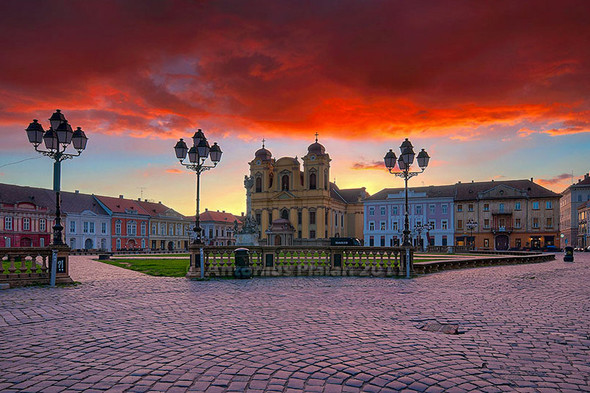Once upon a time the medieval kingdom of Hungary had a southern territory called Bánság that was occupied by the Turks who established a vilayet named after the largest city of the region. Later on, following the expulsion of the Turks, the Habsburgs took hold of the area, then its administration was under Hungarian control until after World War I when it was shared by Romania and Yugoslavia. Today, Banat belongs to Serbia and Romania however some of its villages are on Hungarian territory.
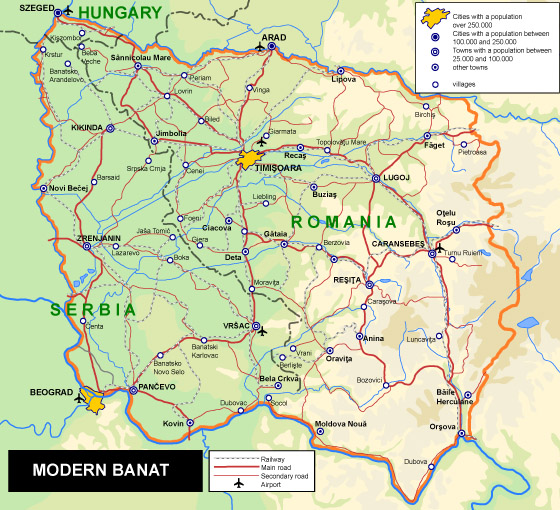
It must have been a beautiful place once! It is bordered by the river Tisza/Tisa on the West, the river Mureș/Maros on the North, the Danube on the South and by mountains on the East. In the 19th century a mixed population of Romanians, Serbians, Germans, Hungarians, Croatians, Bulgarians, Italians, Greeks and Jews lived here. However, the bloody wars of the 20th century have not left much of this multicultural community.
Today, a major part of Banat is located in Romania with its centre in Timişoara, the third largest city of the country, where the Romanian Revolution broke out in 1989. In the middle ages, the city situated near the Bega and Timiş rivers had its natural protection with the vast swampy lands surrounding it. Its actual flourishing (for which it was called Little Vienna for a long while) could only begin when the swamps were drained and the rivers were dammed and diverted. Many of its magnificent buildings still stand in the historic centre of the city which was the first in Austria-Hungary to have public lighting implemented in 1884. Close by the city there are several wine regions today. Let’s have a look at them one by one.
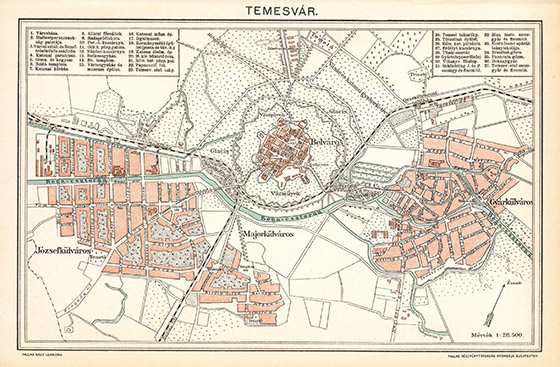
Old map of Timisoara
If departing from Timișoara, we drive east towards Lugoj, we have two choices. Either we take the international main road (or the new motorway) and arrive to our destination through Recaș or we can follow the web of minor roads with much less traffic southward towards Buziaș. In either case we will reach a Romanian wine region.
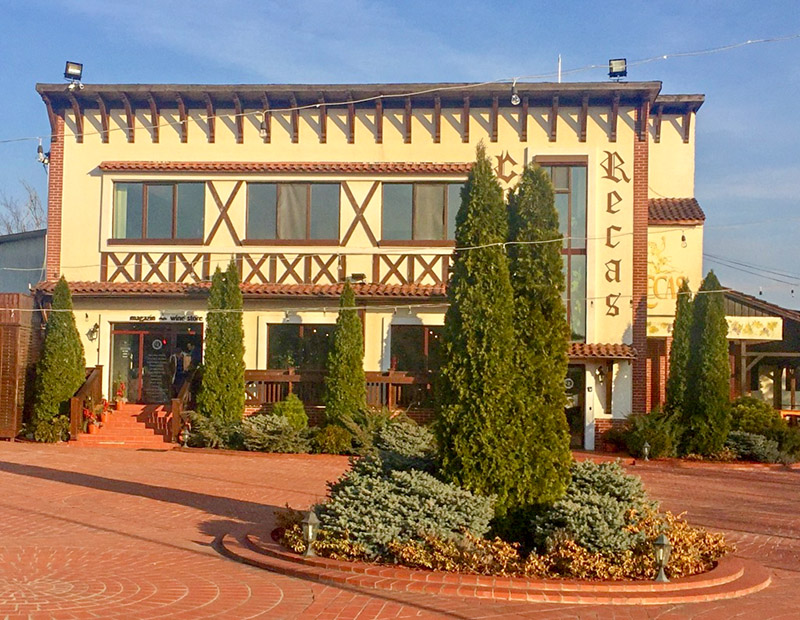
The Recas Winery by Daniel Ercsey
This latter one being further off from the main road is almost completely unknown compared to the former one, as the wines of Recaș Winery are available in all parts of the world. How come that tourism is almost unknown in Buziaș, formerly known as Buziásfürdő (Buzias Bath), the beloved place of retreat of one of the most famous 19th-century Hungarian statesman, Ferenc Deák?
The name Buziaș, an ancient Hungarian or Slavic word meaning an area covered with elderberry according to linguists, was first mentioned at the time of Charles I of Hungary. At that time, it was mainly inhabited by Slavonic and Hungarian people. The population must have been replaced during the Ottoman rule between 1552 and 1718, considering that the sources refer to a 100% Romanian population in 1717. Banat wasn’t returned to the Hungarian Crown even after the Treaty of Passarowitz. The Habsburgs settled in for a longer stay and accordingly the composition of the population only begun to change again after Buziaș was declared to be a health spa in 1819 following the discovery of mineral water sources in 1805. Mineral water bottling began already in 1840 and by 1860, the spa, including an enormous park, nice pavilions, pools, accommodations and technical rooms was fully constructed. Ferenc Deák visited the spa in 1868-69, and Franz Joseph I stopped by in 1898. At that time, the locality, forming a single administrative unit together with Silagiu, was, a leader in wine making and apiculture. This is where the Association of Southern Hungarian Apiculturists was formed in 1873.
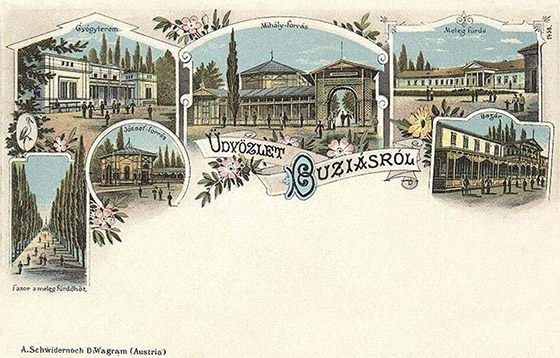
Hello from Buzias! - old postcard from the time of the Austo-Hungarian Empire
The boom of the spa brought along a number of German (and Czech and Slovakian) settlers, which further improved the quality of wines. Those living in Buziaș still remember that on the vineyard almost everything was owned by the Swabians of Bacova and they were also the ones who erected the chapel in the vineyard on the south from Buziaș to Silagiu. Already in 1825, the brilliant polymath, Zsigmond Ormós, who would later become the chief of the county, had extensive vineyards in Silagiu (then known as Nagyszilas) however it really begun to flourish around 1840 with the German settlers as mentioned above. In 1908, Buziaș was described as follows: The health spa with its numerous buildings on a one-hundred-acre flower-garden is the busiest place of the city. The estate is split into two by Király street. The lower part of the health spa accommodates a grand hotel, the administrative building, a carbon dioxide producing facility and a bottling plant. The great kiosk is situated in the middle of the flower-garden with its immense medical room serving also as a dancing saloon. A reading room and a lounge are also accommodated here with a small hotel farther off with the drinking halls of the St. Anthony, St. Michael and St. Joseph springs connected to each other and to the rest of the buildings with covered promenades on a length of a half a kilometre. The boating pond from the centre of which water jets of the Saint Anthony geyser come from a depth of 103 m, is next to the medical room.
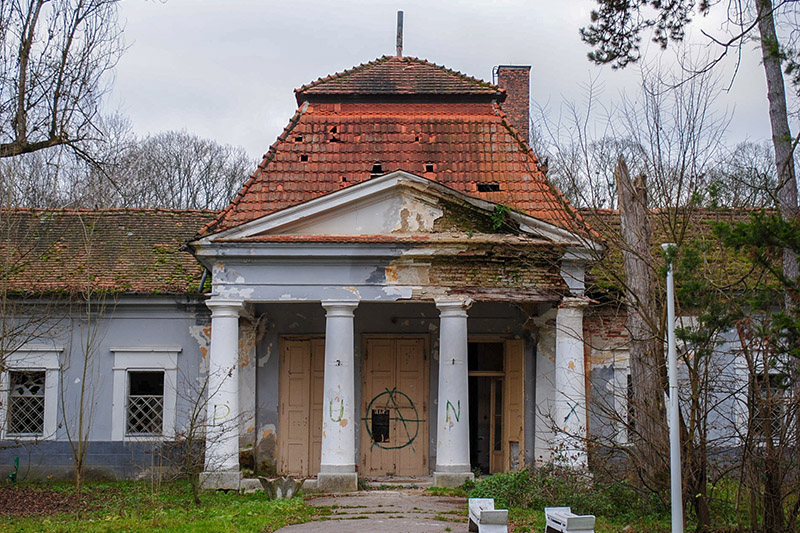
The sad present of Buzias
Today neither Silagiu, nor Buziaș are a popular destination. The two localities could, theoretically, be accessed through the vineyard, though practically it is rendered impossible by the road quality. At both places a Romanian winery is making efforts to revive the old traditions, with more or less success. More, if we consider that their wines are available in Timişoara, their main market, and less because a real boom would also require the revival of the spa in Buziaş. Upon my visit I saw silently rotting pavilions and a rough vegetation in the park. The city has only one, through very good, bistro run under the name Belvedere and there are only a few accommodations used mainly by Romanian groups of pensioners. The public bath was shut down and thermal water is used by two hotels.
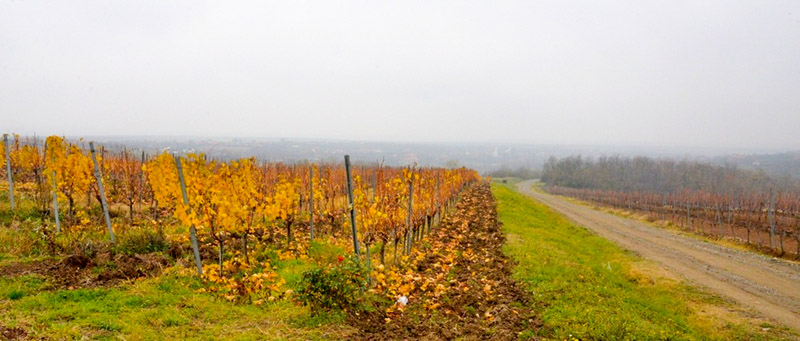
Silagiu vineyard by Piroska Koltai - Wine a'More Travel
The Silagiu wine-district is part of the Banat wine region. Here, schist is covered with sediment containing loess and clay with vine stocks planted in them. The cooperative formed by seizing vineyards mainly from the Germans had 560 hectares of vineyard in 1947 which reduced to 330 hectares in 1999 and continued to shrink ever since. Once the main varieties of the wine region were: Muscat Ottonel (!), Riesling de Banat (Creațad e Banat), Blaufränkisch and Sauvignon Blanc, this latter being in general of a semi-dry, semi-sweet kind. The recovery started in the second half of the 2000s. Until then, hardly any people cultivated vineyards here. Now, at the beginning of 2018 there are four active wineries around Silagiu and Buziaș, namely Domeniile Sera, Crama Dealul Dorului, Crama Thesaurus with its tasting room offering a view of the old spa of Buziaș, and Crama Aramic being the oldest of all with its establishment in 2008.
If you happen to be here, stop by for a glass of wine in the vineyard and contemplate about the transience of the world and lay another brick as foundation for the future with that glass of wine you drink.
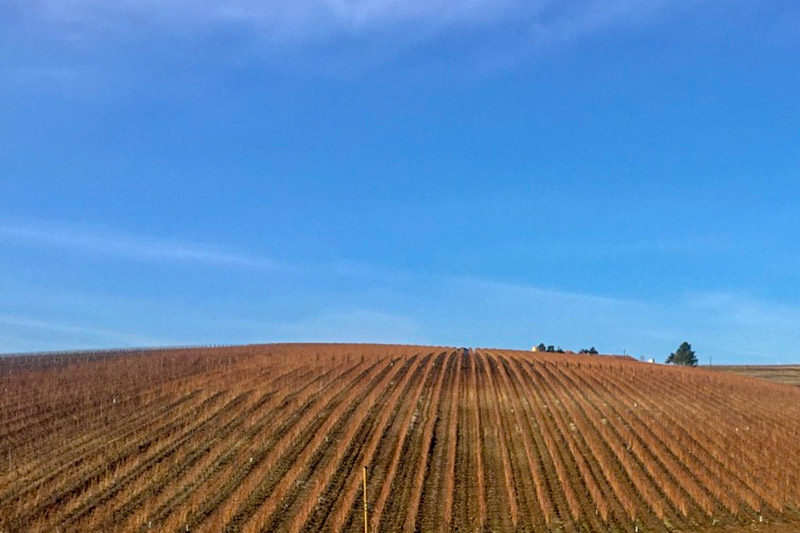
Recas vineyard by Daniel Ercsey
The other wine region we’ve already mentioned has its centre in Recaș and it also owes its existence to the Germans. If researches are right, settlers arrived to the area of Recaș already around the middle of the 18th century. The ethnic mixture of the locality is also interesting. The early Slavic people settling here were the Bulgarians and later Šokci people came from Bosnia. Until the middle of the 20th century the majority of the population was of German origin but World War II and the following period took its toll. Loess and clay covers this area too, but it is known rather for its red wines. The legal successor of the winemaking cooperative cultivating 750 hectares of lands expropriated from the Swabian settlers is Cramele Recaș. Today, the winery has 1000 hectares and its wines have reached all parts of the world thanks to the commercial and marketing system established by its English&Romanian owners. Another important actor of the Recaș DOC, Crama Petro Vaselo has its seat in the neighbouring locality, Petrovaselo (inhabited by Serbians from Montenegro until the 20th century). The Italian owners had a good intuition concerning the wine making opportunities of the area. Maybe they had the chance to taste one of the good Cabernet Sauvignons or Pinot Noirs of the 1970s-80s as, already at that time, the winemaking cooperative enjoyed a nation-wide fame for these wines. As opposed to Cramele Recaș, Petro Vaselo winery’s main market is also regional, i.e. in addition to Bucharest (everyone’s main target for selling) Timișoara is a key destination of their wines. Recaș DOC is situated right next to the new motorway, even the vineyards are visible from the road, and the international airport in Timișoara is only a 15-20-minutes’ drive away. So, we can assure that it is the easiest-to-access wine regions of Romania.
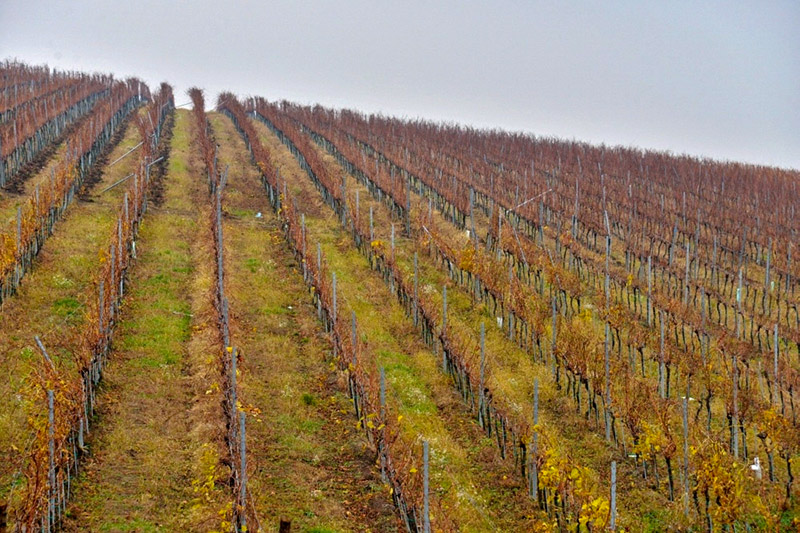
Banat's vineyard by Piroska Koltai - Wine a'More Travel
Let’s go to Serbia!
It takes approximately 80 minutes to arrive to the Serbian border from Timișoara. The way is rather characterless going through a flat land with villages of a population clearly composed of metropolitan intellectuals seeking a quiet environment to live in. On the left, there are mountains now closer now farther. On an almost unswerving road we are heading to the south. The border is open day and night and no significant queuing is expected although this same road leads to Belgrade, the capital of Serbia. Reaching the border, we see a seemingly lonely mountain emerging on the horizon almost out of the blue with flat lands all around it. Drawing closer it becomes clear that the chain of mountains reaches towards the east where the height almost abruptly turns into a city on the great plain. Sunbeams gleam on its church steeples. It is Vršac, the old Werschetz of the Germans, or Versec for the Hungarians, Vârșeț for the Romanians and Virsac for the Turkish. The city, once enjoying great fame for its wines, is nothing but a bored border town today. In the vicinity of the castle ruins, paragliders are taking the best of air currents. Whether we head to the north or to the east, we can be in Romania in ten minutes.
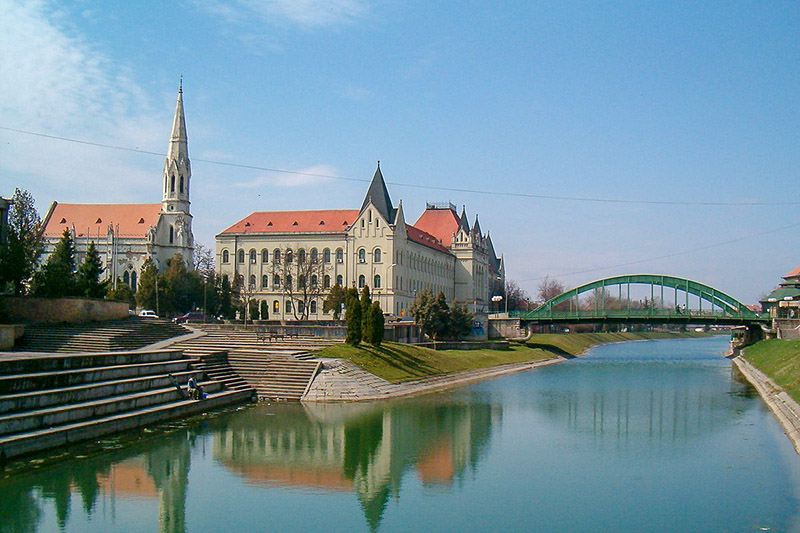
Zrenjanin
On its southern border lies the ill-famed Deliblato Sands, the small Sahara of Central Europe. Free exit towards Zrenjanin or Belgrade is only possible on the west. One gets easily lost in their thoughts in this land.
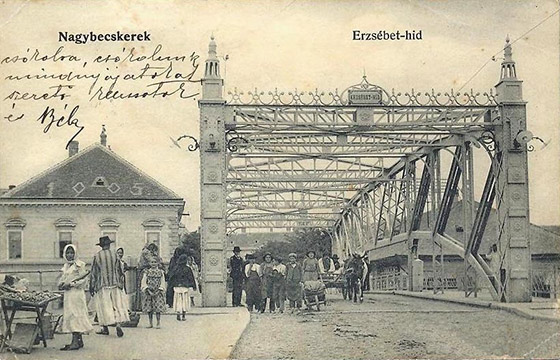
Old postcard from Zrenjanin
Zrenjanin is the location of the first Spanish utopia, a location that is theoretically impossible and a utopia that is practically neither Spanish (Catalan) nor successful. New Barcelona once situated at the place of this city was established in winter 1735 by Catalans expelled from Vienna. But the plains of the newly freed Eyalet of Temeşvar could offer them nothing but swamp and malaria, so it took less than three years to the survivors to sneak back into Vienna. (This fantastic story have already been commemorated in our article about Fruska Gora.)
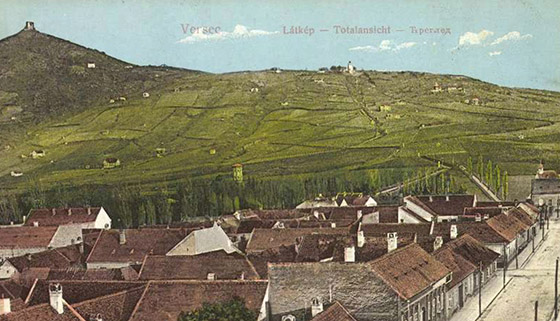
Old postcard from Vrsac
When in September 1863, the baby Franz Herzog was born in Vršac in the Banat, no one would have thought that the son of the mayor of this city displaying typical German features would once become the most celebrated Hungarian writer. But that’s what exactly happened. Little Franz went to school first in Timişoara and then to Szeged, Bela Crkva and Budapest. This latter being the placed of his university studies. He must have learnt Hungarian in Timişoara and Szeged, since at home no one spoke Hungarian. I wonder whether the late writing genius, Ferenc Herczeg liked the wines of his native land. Would he recognise now the city he was born in? Well, today the house he was born in (marked with a memorial tablet) accommodates the local branch of the Serbian Communist Party. And let’s leave it at that….
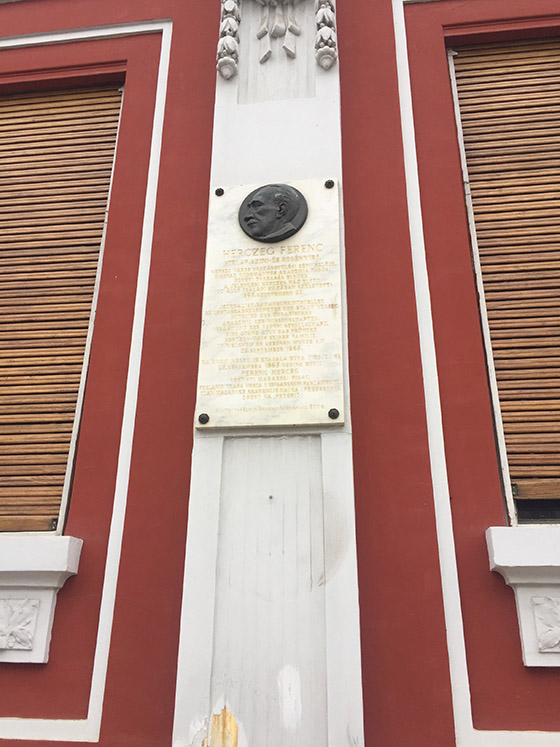
The birthplace of Ferenc Herczeg by Daniel Ercsey
The buildings however have not changed. The taste of the rich bourgeoisie, as well as the tastelessness of the newly rich of the past can still be detected on the facades. We can affirm that Vršac is a fascinating and charming city. And the mountain behind it reminded me of the Tokaj hill, though I may have been enchanted by its position only. There is something ancient about the scenery, the houses, the neighbouring villages and the roads leading to the vineyards which is inexplicably understood and felt by everyone looking for traces of the past at this corner of the world. The melancholy of passing.

The Treaty of Passarowitz
Vršac and the nearby villages began to be populated immediately after the Treaty of Passarowitz. The first Germans arrived in 1719 from Alsace and from the Moselle valley. It’s not hard to imagine that they brought along stocks of Riesling and Gewürztraminer to this distant foreign land. We even know the person by his name, Johann Tetz, who re-founded the completely emptied Gudurica under the name Kudritz. The Vršac Mountains towering high above the plains is surrounded, in three directions, by villages forming the winemaking district. On the north, the most important one is the already mentioned Gudurica but Markovac and Malo Središte, Romanian villages from the beginning with an orthodox monastery in the latter, and Veliko Središte, an ancient Serbian village also belong here. Veliko Središte is an exciting village in itself because – although almost nothing remained of its significant Hungarian, German and Czech minorities – both of the castles built by the family Lazarovics still stand here. One of them has a function of a school but the other one is still waiting for its saviour. The roof collapsed and only traces of destruction can be found inside the building. And when one enters Gudurica, he can see not only a vast number of wine shops focusing on tourists arriving by busses and offering sometimes undrinkable plonks but also that its houses are the imprints of a different era and a different economic environment. It is characterised by thick stone walls, three-hundred-year old cellars and swerving streets.
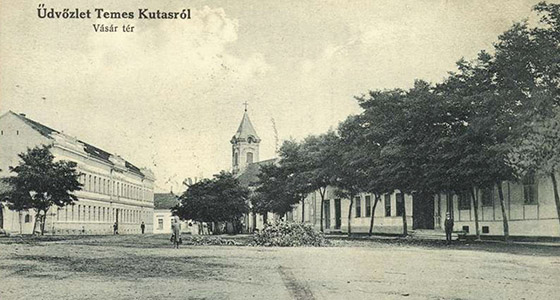
Old postcard from Gudurica
On the south of the Vršac Mountains lies Sočica, Jablanka and Mesić, all the three being typically Romanian villages. In Mesić an orthodox monastery has been standing on the slopes since the middle ages. And in the end, on the western feet of the mountain we can see the two steeples of the Roman Catholic Church of Vršac named after St. Gerard.
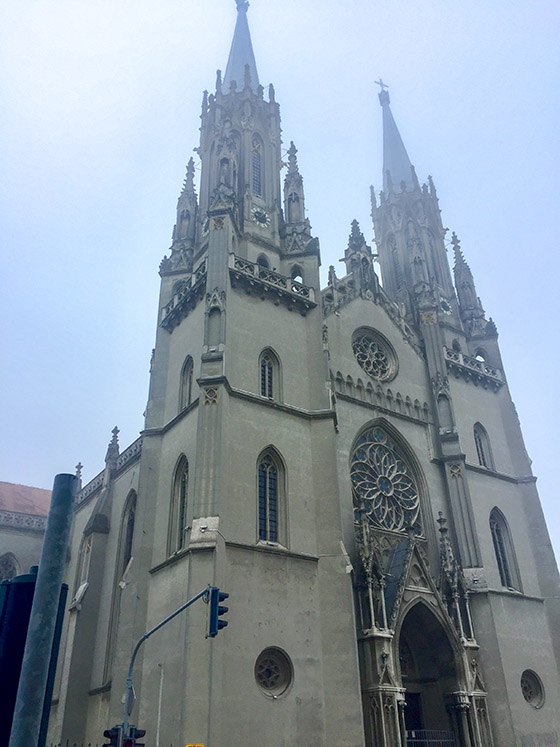
The Roman Catholic Church of Vršac named after St. Gerard by Daniel Ercsey
The most well-known wine of the old Hungarian county was also from Vršac. In 1874, Elek Fényes gave the following description:
“Considering its goodness, the wines of Vršac deserve the first place among those of the county. It deserves a special mention in Vršac that the northern side of the mountain offers better wines than the southern side for what the reason may have to be looked for in the position of the mountain.”
After the railway was completed in the locality in 1858, a Swiss wine trader, Bernard Staub established perhaps the most modern winery of the era under the name Helvécia, which brought the wines of Vršac to world fame. This upswing could not last long, though. The wine region that was granted the rank of an independent wine region under the name Vršac-Bela Crkva in 1893, had a hard time in recovering from the Phylloxera plague. This was followed by the change of borderlines, then the expulsion of the Germans and in the end by collectivisation. The local wine making cooperative, Vršački Vinogradi was created and completely ruined both the name of Vršac and the native Banat Riesling (Kreaca in Serbian) variety during its 40 years of existence. Its legal successor still holds 1600 hectares (!), but they could only make their way to the news with their bankruptcy and a failed attempt to sell the estate to Chinese buyers.
Anyone looking for drinkable wines in the wine region can do but one thing: ring the bell of Rnjak Winery in Gudurica. New winds seem to sweep the Vršac wine region and maybe those will revive the past, whose own lands were seized by others, elsewhere. I frankly wish them much success.
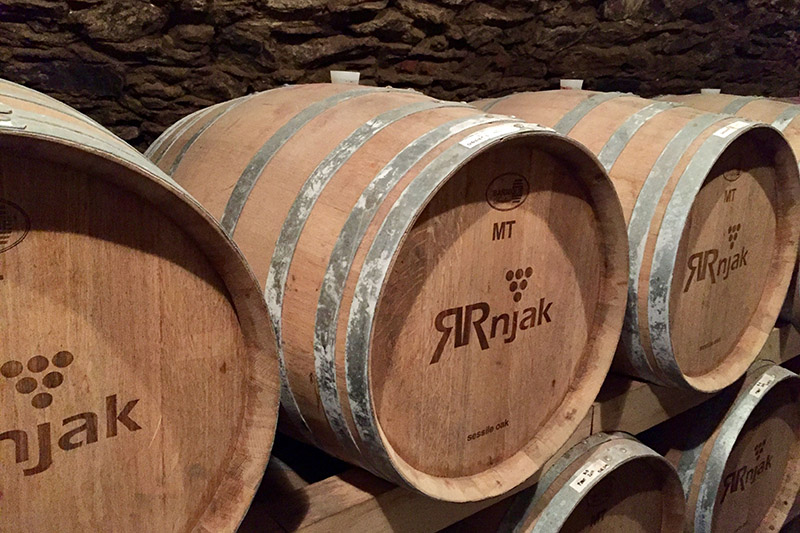
Rnjak Winery by Daniel Ercsey
With this, we have reached the end of our adventures in Banat. We visited two countries or, if you prefer, three wine regions. From here we can choose to go to Novi Sad, Fruska Gora or Belgrade through Zrenjanin or to the wineries around Smederevska Palanka, or to Bela Crkva, then over the Iron Gates to the Romanian Oltenia, the Serbian Negotinska Krajina or to the wineries in the Bulgarian Danube valley close to Vidin. There is an inexhaustible number of sights to see, stories to hear and wines to taste in Central and Eastern Europe and the Balkans. So, do not hesitate! Have a nice trip!



